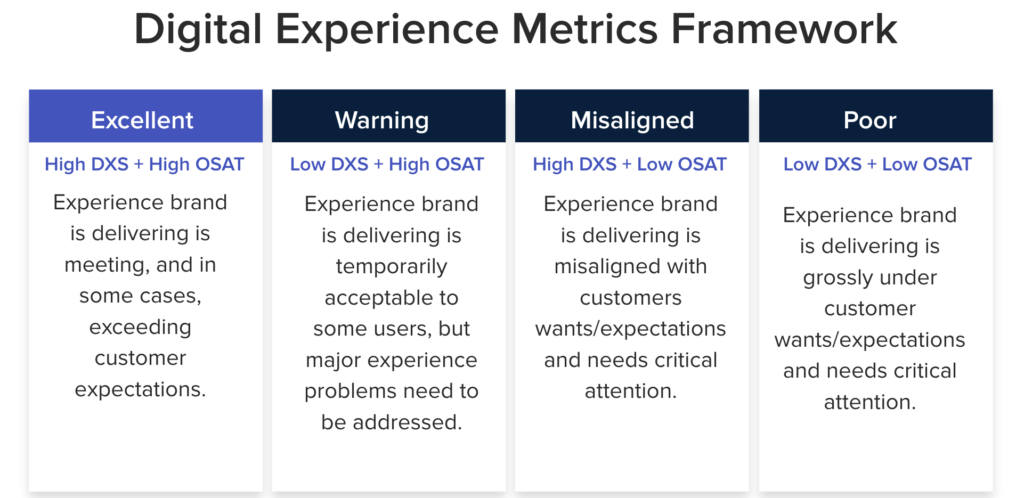A Quick Guide to Understanding Digital Experience Score (DXS) as a Core Metric
August 2, 2022
Digital Experience
Are your digital channels meeting customer expectations? Medallia’s Digital Experience Score (DXS) reveals the state of online journeys for every user — regardless of direct feedback.
Every leading brand has a few core metrics that help measure the success of its customer experience program. These metrics, such as overall customer satisfaction (OSAT) and Net Promoter Score (NPS®), represent direct feedback from customers on their experience with the brand.
But feedback is not always available for every experience. What if there was a way to measure the experience of every visitor?
On the digital channel, you can — using Medallia’s Digital Experience Score (DXS). Like established experience metrics, DXS is designed to measure the success of a brand’s CX program, specifically on the digital channel. However, unlike established experience metrics, DXS measures the experience of every single visitor, not just those who give feedback.
Combining DXS with metrics like OSAT and NPS gives teams unprecedented insight into customers’ digital experiences, helping teams automatically identify the highest-impact actions that will drive customer engagement and business growth.
What is Digital Experience Score (DXS)?
Medallia’s DXS is the collection of every customer interaction across each digital property, rolled up into one comprehensive score. DXS analyzes five key pillars of digital experience: Navigation, Frustration, Engagement, Form, and Technical.
Each pillar score is calculated using behavior detection algorithms, where Medallia automatically uncovers specific user behaviors that shed light onto the overall digital experience. For example, Medallia may uncover behaviors such as high focus time on a particular page, or copy and paste behaviors, which indicate high engagement.
Ultimately, this data is designed to evaluate the user’s “digital body language.” By providing this intimate view of each visitor’s digital experience, leading brands can understand how likely customers are to complete any goal or action through the digital channel.
Understanding DXS and Established Experience Metrics Together
Medallia’s DXS is not meant to replace established experience metrics. Rather, DXS supercharges existing metrics by accelerating time to insight and uncovering higher-impact actions.
Discrepancies between DXS and established metrics such as NPS and OSAT are the starting point for quick, accurate, and impactful action plans.
Medallia works with thousands of brands every day to establish and expand their experience programs. We’ve developed a simple framework for understanding how DXS and other established experience metrics work together. This framework consists of four main categories:

Note: in this example, we take OSAT as our established metric of choice; however, this framework is applicable to any established experience metric, such as NPS, CSAT, etc.
Each of these categories sheds light on a particular aspect of the customer’s experience that can help teams take nuanced, specific actions that lead to better results.
Excellent: High DXS + High OSAT
“Excellent” is the ideal scenario, where both DXS and OSAT are high on your digital property. “Excellent” means customers are having a positive experience, both in their digital interactions (as measured by DXS), and in their impression of their experience (as measured by OSAT). The brand is meeting, and in some cases, exceeding expectations.
But brands who are delivering “Excellent” experiences shouldn’t rest on their laurels. There are a few key steps to take to capitalize on this success and future-proof their business. These include:
- Create Champions: Incentivize customers with referral programs, follow up with offers for enrollment in loyalty programs, or re-engage customers with requests for online reviews.
- Upsell or Cross-Sell: Collect feedback by sentiment to understand what the customer is likely to buy next, set up journey orchestration directing those segments to a relevant product/service, and re-target customers with relevant marketing campaigns.
- Strengthen Engagement: Follow up with personalized offers for that customer, or test new product offerings with a particular customer segment for market feedback.
Ultimately, achieving “Excellent” means that the brand is in a position to make strategic advancements in their experience program, truly positioning themselves as a leader in the market.
Misaligned: High DXS + Low OSAT
“Misaligned” refers to when DXS is high, but OSAT remains low. Although the digital interactions and the customer’s behaviors did not present any major problems, the customer was still unsatisfied with their overall interaction. Therefore, what the brand is delivering is “Misaligned” with customer expectations.
To improve misaligned experiences, companies need to consider: what do customers expect when they come to this property that they aren’t receiving? What needs to be changed to meet these expectations? Some places to begin this analysis include:
- Content: The actual content on the digital property does not meet customer expectations. This could range from the price of products, to the offerings available, to the various blog posts promoted on the site.
Potential solutions to a gap in content include conducting market research and adjusting offerings to meet customer expectations, or surveying customers by segments and adjusting offerings accordingly. Recommended methods include A/B testing and personalization tools.
- Journeys: The customer journey did not align with that customer’s historical relationship with the brand. For example, a customer who has already purchased multiple products and is looking for a help page is instead redirected to a first-time purchasing journey.
Potential solutions to misaligned journeys include refined segmentation of existing customers with curated journeys by segment, and advanced real-time journey orchestration based on customers’ behaviors, customer history with the brand, or customer feedback.
- Capability: The customer’s desired activity is not supported by the digital property. For example, the customer may want to renew their package/plan, but this self-service capability is not accessible on the website.
Potential solutions include updating the digital property based on the most common customer requests.
Usually, “Misaligned” means the brand is in a position to deliver best-in-class digital experiences to their customers, but have not yet identified the best ways to do so.
Warning: Low DXS + High OSAT
“Warning” refers to when DXS is low, but OSAT remains high. Although some customers provided positive feedback, the digital experience is severely lacking. In this case, customers who are not providing feedback may already be abandoning the digital property. If significant changes are not made, customers who are providing positive feedback will likely become detractors.
“Warning” means a strategic change is needed. What are the biggest issues customers are facing? How quickly can the necessary changes be implemented? Some potential interpretations of the “Warning” category include:
- Temporary Acceptance: Demand for the product or service is high, and customers are temporarily willing to navigate a poor experience to convert. However, if a competitor offers the same product with a better experience, the brand faces a large risk.
Potential solutions to the problem of temporary acceptance include analyzing customer experiences on aggregate to identify the most urgent/common issues faced, and prioritize those fixes. Another solution may include analyzing customer experiences by segment, and fixing the most urgent/common issues for the highest-value segments first, and working from there.
- Silent Detractors: Although feedback is high, there is an underlying experience issue that is not represented in feedback, but still significantly affecting KPIs. For example, although feedback is high on a certain conversion funnel, actual conversion rates are significantly below expectations, indicating that the feedback is not necessarily representative of the overall experience.
Potential solutions to the problem of silent detractors include cross-referencing experiences with other teams (e.g., contact centers or account managers) and/or data sources (e.g., CRMs) to uncover any significant issues. Other solutions include creating a more targeted feedback program to focus on what silent detractors may be experiencing, or resolving 1–2 urgent issues to see if KPIs are impacted.
Generally, “Warning” means that the brand should be prepared to make serious investments in their digital experience in order to keep up with the marketplace.
Poor: Low DXS + Low OSAT
“Poor” refers to when both DXS and OSAT are low. “Poor” means customers are having a negative experience, both in their digital interactions (as measured by DXS), and in their impression of their experience (as measured by OSAT). The brand is severely performing under expectations.
“Poor” means both strategic and tactical changes are required to improve future experiences. Some potential solutions to “Poor” include:
- Deeper Customer Understanding: A deeper understanding of customer expectations and demands are needed. This can be achieved by identifying high-priority customer segments and collecting targeted feedback, or identifying critical customer journeys and prioritizing optimization efforts.
- Improved Digital Offering: The digital property the brand is offering is not viable in today’s experience marketplace, and serious investment must be made to meet expectations. Determining what these investments should be can include conducting market research on the quality of competitor’s digital offerings, identifying the urgent issues that are preventing good experiences and mapping out solutions, or investing in tools that support a scalable, positive digital experience.
“Poor” indicates that serious work is needed if the brand wants to remain competitive in today’s experience marketplace.
Enhance Digital Experiences with DXS
By analyzing the “digital body language” of users and complementing these insights with other established metrics, Medallia’s DXS empowers your team to view the full picture of how customers are interacting with your digital presence. This key metric should be included in your overall digital experience strategy to ensure you are addressing all pain points, capitalizing on opportunities, and personalizing experiences along every touchpoint, resulting in seamless online journeys.
To learn more about all the tools you need to optimize your digital experience, download our guide, The Essential Tools of Digital Experience Analytics.






